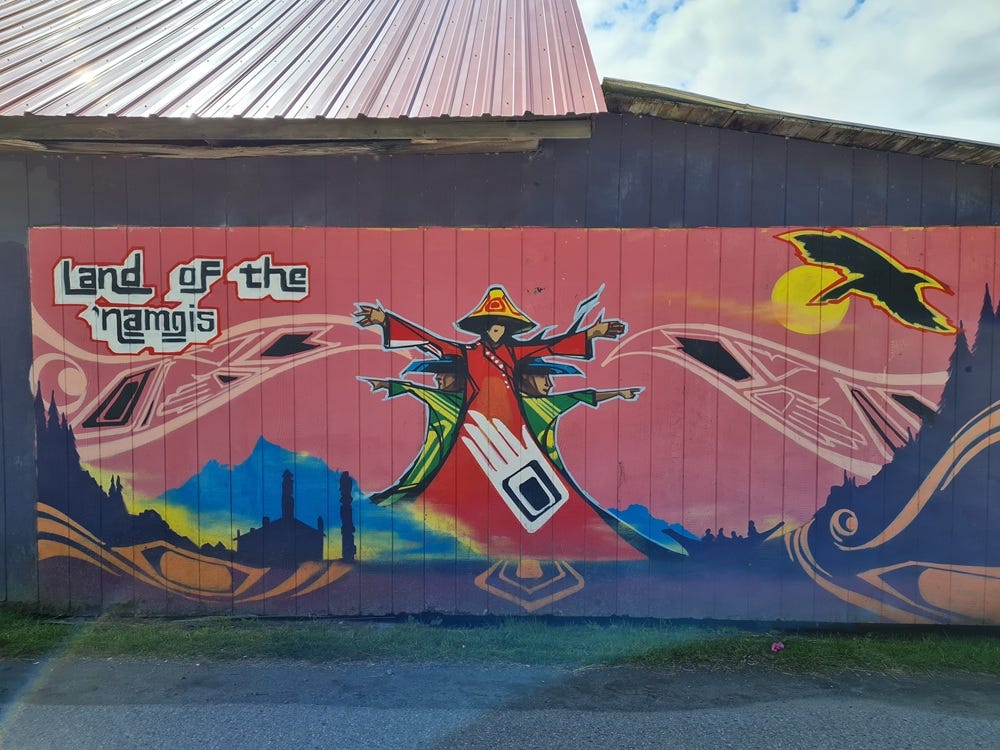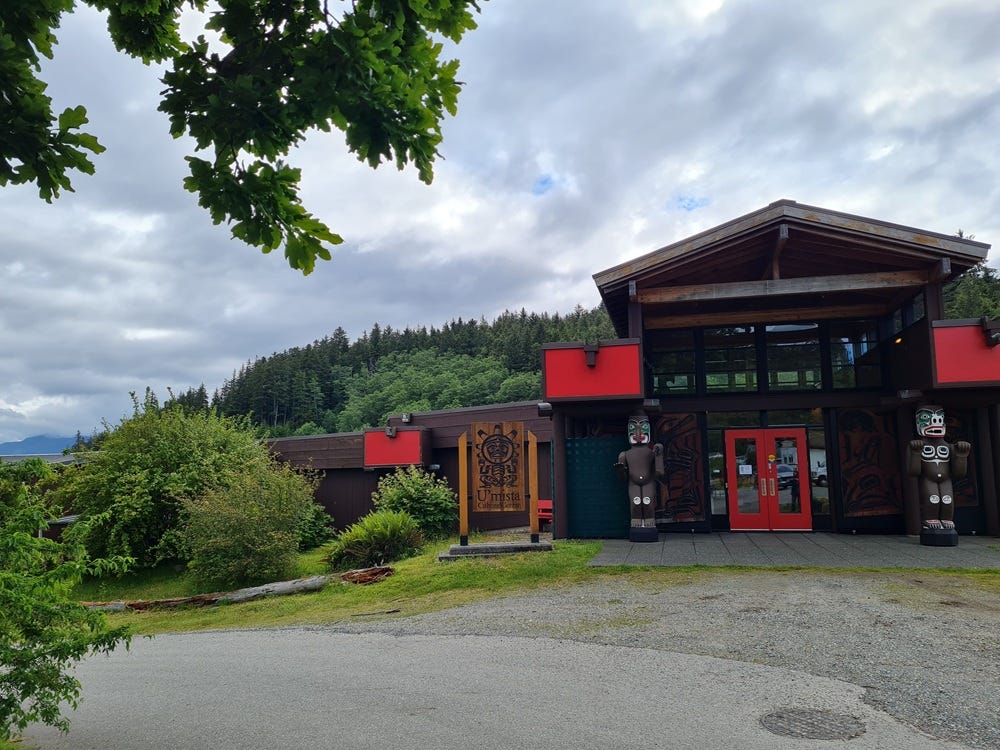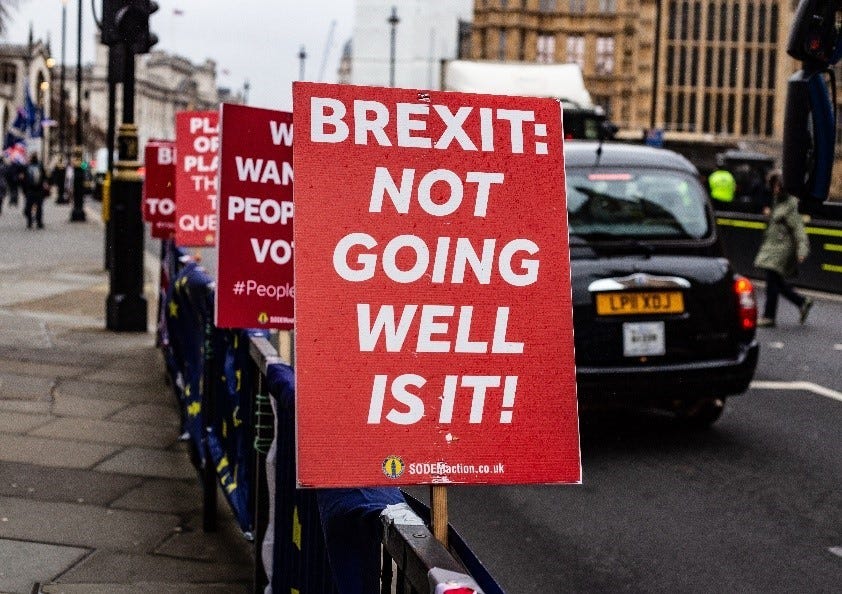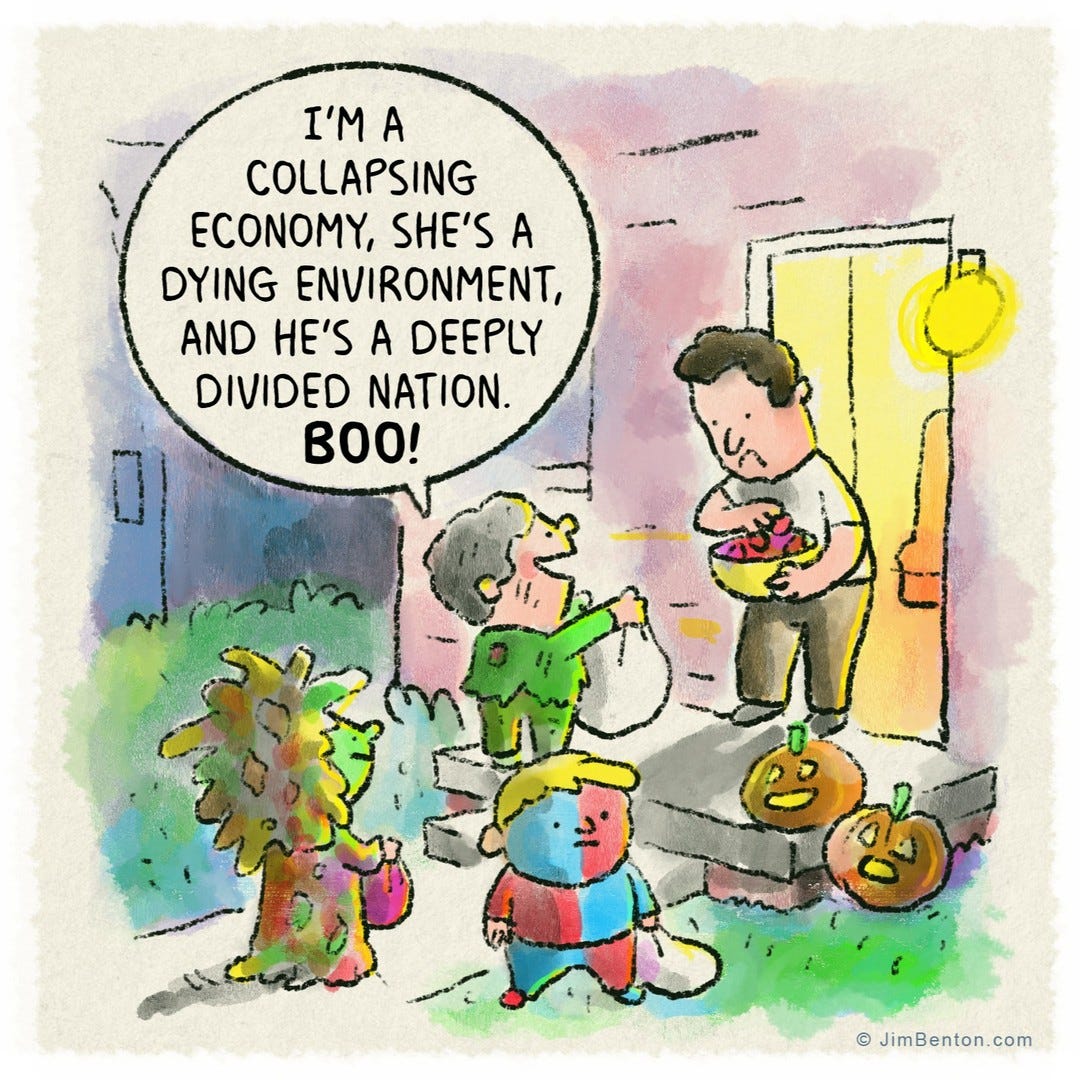The End
There was this one trip about four years ago where we left Wellington at about four in the morning. Midwinter in New Zealand, the air was glacially cold, exacerbated by an angry rain that lashed out at the shuttle taking us to the airport. After a coffee in artificial light, we caught a flight to Auckland (1 hour plus transit) then from Auckland to Vancouver (13 hours plus transit).
Emerging from Vancouver international airport, we were physically stunned by the heat and the brightness of the sun. Taking the shuttle bus to the domestic terminal, we sat in a wood panelled cafe, drinking coffee for two hours, then caught a flight to Vancouver Island (45 minutes plus transit). The plane was a tiny 16-seater, the trip beautifully surreal. Drifting over an endless stream of dark blue water and clusters of green islands, we eventually landed in Margaret River, a town halfway up the northern coast of the much larger Vancouver Island.
Margaret River airport was quiet, the surroundings lush and lovely. It was warm and sunny. After the winter chill of Wellington and more than a day of travelling through metal, chrome and concrete, we felt like characters from a movie who’d ended up on the wrong set. It must have been around mid-day when we got off the plane. There was another coffee, a hire car, and then a two-hour drive further north to Port McNeil. On the way, I had to stop the car to let a bear and two cubs cross the road in front of us.
At the small town of Port McNeil, we caught the ferry to Cormorant Island, or Yalis, as it was originally known. Originally populated by the Kwakwaka'wakw, the island was used as a summer base by the ‘Namgis First Nation people who run the’ Umista Cultural Centre – where we hoped to see potlatch artifacts returned to their owners after many decades of cultural repression. In a nice kind of ethical equilibrium, the centre’s located beside the demolished St Michael’s Residential School, the site where so many of the ‘Namgis people were culturally repressed and abused.
The journey to the island took a little over an hour (plus transit). For most of the trip, I sat up by the bow, watching islands drift past to either side as we surged soundlessly through the water. It was the first time I’d ever been on an electric boat, never mind an electric ferry boat. Disembarking at Alert Bay, I stared towards the ’Umista Cultural Centre, bleary with jetlag, leaden with fatigue, feeling wearier than I’d ever felt before, but also relived to be so close to my destination.
I remember that sensation distinctly, all the more so because I now feel it again. Having almost made it to the last month of 2024, there’s just another 31 days till the metaphorical start of a conceptual new year.
2024 has been something of a hard slog for our family. Racked by illnesses, deaths, and other challenges, these events have taken their toll on my family but also on my creative/cultural output. Given that I have mouths to feed and people to support, I’m obliged to reprioritise my efforts and activities from here on in. As a result, I’ll be pulling back from ‘Vóg’. As usual there’ll be no newsletter in December (Bah! humbug!) but from next year, the newsletter will be far shorter and restricted to books (mostly my own). Any in-depth articles will be reserved for those supporting the ‘paid’ section of the newsletter (and for whose support I’m very grateful).
Although initially set up to update people who enjoy my books on upcoming projects and releases, over time ‘Vóg’ became a means for me to ‘think aloud’ in the creative and cultural spheres, a kind of public diary to myself on the things that interest me and inspire me. Thanks to those of you who’ve put up with my blathering for the last few years.
If you enjoy my books, feel free to continue following. If you enjoy the wider creative/cultural work I do, maybe consider the ‘paid membership’ option where you can at least enjoy free access to what I produce. In any case, for those who remain, I’ll see you on the other side of 2024.
Have a safe and peaceful Christmas and New Year.
Brian
[‘Neighbourhood’ by Kasia Derwinska]
Currently In Production
(1) FIONN: The Betrayal [currently at 42,000 words]
Last month this figure was at 36,000 so it doesn’t look like too much work has happened. In fact, I’ve actually been spending a lot of time on the first four chapters and they’re currently off with Madame Blackwing for editing (i.e. relatively close to final draft).
The release date remains at 5 April 2025 (the pre-order links [digital only] can be found by hitting the image below). I had hoped to get the usual free copy out to ‘paid newsletter’ members for Christmas but now I’m working to a January date for that. Sorry, guys.
Although many of the plot elements will be resolved in this work, I’m now pretty sure the series will require a seventh book to finish.
(2) Irish Mythology 101 [42,000 words]
This is still coming along slowly. No release date assigned as yet
(3) Audio Project
I’m currently in the process of trying to adapt one of my books into audio form. This is really just a pilot at this stage but I’ll share the result with paid members next year.
Poster Girl by Veronica Roth - Review
I picked up Veronica Roth’s ‘Poster Girl’ – a dystopian mystery – last month as I was intrigued by the premise outlined in the back cover blurb. This reads as follows:
Sonya Kantor is paying for her parents' sins. Once the privileged daughter of a powerful regime, Sonya is now fighting for scraps in the ‘Aperture’, an unconventional prison for members of the now-collapsed Delegation. Sonya has no hope of clemency. She was the regime's former poster girl and the new government had to make an example of her.
But when Alexander Price, the brother of her now-dead fiancé's, appears and offers to broker a deal for her freedom, she allows herself to imagine life outside the Aperture. Her deep knowledge of the Delegation and her father's dark dealings could be the key to finding a missing girl named Grace. Find Grace, gain freedom.
The path to find Grace leads Sonya through an unfamiliar post-Delegation city with echoes of her former life at every turn.
She … yadda, yadda, yadda.
So, there you go. That pretty much outlines the overall plot (although that summary feels unnecessarily confusing in parts). To clarify therefore, Sonya Cantor was the daughter of a high-level person in an authoritarian, high tech government known as ‘The Delegation’ (a bit like the State in the famous ‘1984’ but with modern technology).
While ‘The Delegation’ was still in power, Sonya’s face was used in one of its key propaganda posters so almost everyone recognises her/knows who she is. Now, ten years later, the ‘Delegation’ regime has fallen, and all its instigators and key supporters are in a prison known as the ‘Aperture’. Sonya is offered a chance of freedom if she can find a girl who disappeared under that regime.
What I found most interesting about this book (from a technical story writing perspective) was that the story is set in the aftermath – that’s to say, two decades after the ‘worst’ has actually occurred (i.e. decades after the dystopian society was operating and another ten years after it’s been removed). Prior to the events in the book, the Delegation Government had been very much an authoritarian regime, operating hand in hand with commercial technology companies to rule its population with an iron fist. Citizens, having already sacrificed essential freedoms for the convenience of cell phones and the ‘cloud’, lived under constant surveillance in the form of the ‘Insight’, a kind of ocular implant that tracked everyone’s every word or action and subsequently rewarded or punished them according to a kind of ‘gaming’ model (Descoin points). Over time, therefore, the Delegation had used that social media mechanism to push everyone to adhere to its moral code, no matter how destructive that was.
The story is also interesting in that it tells the story from the viewpoint of someone who benefitted personally as a privileged member of that regime, someone who although too young to have actively implemented it, nevertheless participated in and helped facilitate it.
So, is it any good?
Well, yes and no, depending on what you’re looking for. As a mystery story, Poster Girl is probably not that thrilling. The core ‘mystery’ itself is pretty good and there are some excellent ‘reveals’ that help propel the story forward, but its impact is somewhat undone by the lack of any real narrative tension running alongside it. I think part of that is down to the author’s choice to focus much of the story on the protagonist’s (Sonya’s) inward self-development and self-discovery, a dominating narrative layer that means much of the dramatic potential of the actual mystery is lost.
That said, the protagonist’s character development is pretty good. Over the course of the book, Sonya’s insight and understanding of her own privilege grows as certain things come to light during her search for the missing girl. Confronted with the reality of how the Delegation controlled every single aspect of a person’s life (and destroyed those who didn’t align), she struggles to come to terms with those truths and the fact that some of those people she saw as the enemy (those representing the new regime who’ve kept her imprisoned) had good reasons for doing what they did. There’s also a bit of a budding love-hate romance in there but, to be honest, its pretty ‘by the numbers’ and felt a bit contrived.
The world building and allegorical commentary around a previously democratic society that slipped into the control of an authoritarian government (and, fortunately, escaped again) is particularly very well done and builds prophetically off the slippery slope of the current capitalist technology approach (monitoring and commodifying absolutely everything you do) that western societies are struggling to cope with.
I’d never previously read any of Roth’s works, so it came as a surprise to learn that she was the author of the commercially successful ‘Allegiance’ series of books (which were also adapted into a series of films). Predominantly known as a ‘Young Adult’ author, this could be why I saw several reviews where people complained that the book – a high-concept novel – read in parts like a ‘Young Adult’ novel. There was certainly some simplification in the story telling style but, to be fair, I certainly wouldn’t go that far. In my own mind, to do such a high-concept story justice would probably have required a far longer book (or a series) nonetheless, for the short book that it is (300 pages) Roth does a relatively decent job and I’m sufficiently impressed by her work to try out another of her later novels.
Slipping into Dystopia
Certainly, one of the reasons I was drawn to Poster Girl was the fact that I was working on some similar high-concept work ( my non-creative, conceptual design work) I was doing at the time. Sometimes when I’m doing projects and unrelated general reading at the same time, I can find certain aspects of both activities aligning in unexpected ways (always a good spur for creative extrapolative thinking) and that was certainly the case here.
The project (and the subsequent piece below) relates to a series of conceptual articles I was writing on the major societal changes of the past 80+ years and the risks they bring with them for western democracies. I usually keep my two work programmes separate but, on this occasion, it seemed relevant for inclusion. I should warn you, that its a bit ‘technical analysis’, so feel free to skip it if you’re not up to it.
Sliding to Dystopia
There’s been a general malaise settling over much of the western world in recent years, some of it instigated even before the effects associated with the advent of Covid-19. If you’ve been getting the impression the world has increasingly been going to hell in a handbasket therefore, it may help to know that at least you’re in good company.
In terms of conceptual design, one way to understand how we’ve got to where we are, is to look back at the key societal influences on western societies over the last few decades and then work out the higher-level patterns behind that. There are a number of methodologies for doing this but most end up with a kind of patchwork summary for interlinked societal changes. Some of these approaches are better than others. All of them have limitations, however even a basic analysis allows you to get a rough understanding of the patterns in societal power shifts and influence over that period.
Below, is a simplified overview for the 1940 to the 2020s (note, this is very much ‘indicative only’ - to give an indication of the scale and types of societal events considered).
1940s: World War II ends. Breakdown of existing empires and resulting emergence of new states and governments (Vietnam, India, Pakistan etc.). The Cold War dawns. Establishment of new international institutions such as the United Nations, World Health Organisation, The International Court of Justice, etc.
1950s: Post war economic boom. Cold War escalation and Korean War. Civil Rights movement.
1960s: Baby boom. Vietnam. Environmentalism. Ongoing civil rights work. Ongoing women’s liberation work. Emergent media. governance systems put in place
1970s: The Vietnam War and the Anti-War Movement. The United Nations Environment Programme (UNEP) established. Post-civil rights movement era. Roe-Wade in the US.
1980s: Collapse of USSR. Introduction of Reganomics and Thatcherism. Advances in genetic and digital technology. Global Internet beginnings. First large-scale environmental disasters (Exxon Valdez oil spill, poison gas leak in Bhopal). AIDS.
1990s: Google and Amazon. Increased popularity of the Internet. Collapse of the Soviet Union. Establishment of new international commercial institutions (World Bank, World Trade Organisation, etc.). Commercial internet services. Ongoing globalisation, development of IT systems. Commercial internet start-ups. Commercial pocket technology (e.g. iphone etc.). Inter-country inequality.
2000s: Social Media (Friendster to Facebook and others). Global financial crisis. Kyoto Protocol. Dot-Com IPO Bubble/collapse. Enron Scandal.
2010s: Cryptocurrency Emergence. Intensified interconnectedness of global markets. More extreme environmental events (hurricanes and tropical storms). Social protests (Occupy Wall Street, Black Lives Matter, LGBTQ Rights, #MeToo Movement etc.). Increase in mass shooting events. Same-Sex Marriage.
2020s: Brexit. Increased Climate Disruptions (catastrophic wildfires, bigger and more frequent storms, and more intense droughts). China asserts financial might. Covid-19 pandemic.
Obviously, looking back at it like this without some kind of analytical framework means it looks quite the incoherent mess. All the same, by digging carefully you can still start to identify some vague outlines of potential (i.e. unconfirmed) patterns over that time period. Some that I picked up (from previous work projects and using different conceptual models) include the following:
Following the WWII, the western world works in greater unison in an effort to prevent such a disaster from occurring again, predominantly through the establishment of humanitarian-based international organisations and agreements (e.g. United Nations set up, World Court etc.).
From the 1940s to the 1980s, there’s a distinct shift in the influence of the key established western power entities (empires/governments, dominant religions, dominant business entities, etc.), leading to increasingly diverse populations and growing democratic processes.
The rising power and influence of commercial entities (fuelled by a reduction of government regulation, free market economy, globalisation, reduction of government spending on representative populations etc.) has led to a distinct reduction in the power base/influence of national governments. Many global companies are now far more influential on a country’s population than the national governments of those countries.
The rising power and influence of commercial entities has led to a decreasing effectiveness of democratic processes. This, in turn, has led to a corresponding increase in the transfer of public funds previously used for public benefit (e.g. national education/health/social security etc.) to commercial use in some western nations. Generally, the latter involves supporting failed commercial entities, business start-ups, business developments etc.). A corresponding reduction in the associated public tax intake has also reduced the public spend for the benefit of national populations.
Decreasing effectiveness of democratic processes leads to increased societal inequality from the late 1990s with a smaller number of commercial entities consolidating previously public resource and finance.
Decreasing effectiveness of democratic processes leads to decrease in credible, independent information sources.
Decreasing effectiveness of democratic processes and inequality leads to Increasing civil unrest/ increasing environmental impact.
These are all very high-level patterns (naturally) but I don’t think there’s much in there that you could really disagree with (although commercial entities and complicit governments might argue differently). At the same time, it’s interesting to see how the post WWII hubris and efforts to spark a kind of societal evolution for humanitarian benefit was eroded over time, particularly in the 1980/90s. From that point on, the western countries seem to have started to ‘devolve’ again.
It’s also interesting to note how that ‘societal devolution’ (prompted by over commercialisation) has resulted in a corresponding reduction in the life expectancy for western populations, a decline in youth (among under-30s) happiness and wellbeing, and huge increases in mental health issues and addictions.
Given the greater level of capitalism in the modern day United States (and its limited ‘two party’ based democracy), one might have expected to see the first national-scale, self-inflicted ‘societal rupture’ there. In fact, that appears to have occurred in the United Kingdom (which in hindsight, of course, has a far longer history of inequality) when a conservative government (aided by commercial misinformation campaigns) voted to introduce ‘Brexit’.
For anyone with any strategic nous, the detrimental results of ‘Brexit’ were inevitable, of course (although the British Government will continue to deny this). Essentially, the United Kingdom is now extremely diminished in terms of its international influence, its financially broke, and its facing huge societal inequality and upcoming environmental problems. Not to be outdone, the United States now appears to have initiated its own Brexit equivalent but parts of Europe (particularly France) don’t seem too far behind.
The mega scale ‘societal ruptures’ can generally be traced back to at least two decades worth of poor governance, an increase in unregulated commercialisation, and a corresponding growth in societal inequality. This same general pattern however, seems to prevail in most western countries to differing degrees, even here in New Zealand and back in Ireland.
What happens next?
For every country, that’s going to be different result as they all have different governance systems, commercial regulatory approaches, etc. etc. That said, the governance systems (which dictate the assigning of a country’s resource) of every western country I’ve looked at, appear to be locked into the primary objective of national economic growth (in most cases, to the detriment of the health, safety, and wellbeing of the populations they’re meant to represent). Unless governments are forced to change and commercial forces reined in, inequality will continue to increase, the environment will continue to degrade and mega scale ‘societal ruptures’ are inevitable. The most significant of these will probably be environmental. Having now bypassed the safe temperature level for climate change, the next 10-15 years are likely to result in increased climatic events of escalating scale and impact.
What does it all mean?
For me the most interesting part of this is the lack of any consideration around the obvious patterns that are impacting on our lives and our children’s lives. Every government in the western world has staff resource and departments assigned to consider future strategies and the impacts on its population. If a part-time Irish analyst down in isolated New Zealand can work this stuff out on the back of an envelope, why haven’t the government or academics raised hell about what’s coming our way?
And, I guess that’s what you need to understand if you want to fix it.
Woah! That all sounds a bit doomy and gloomy. Here! This’ll cheer you up!
On that positive note, that’s all I’ve got for November. For those of you still with me, you’ll hear from me again in January 2025.
This month’s paid content section includes Chapter 1 of FIONN: The Betrayal.
Keep reading with a 7-day free trial
Subscribe to Irish Imbas’s Substack to keep reading this post and get 7 days of free access to the full post archives.













